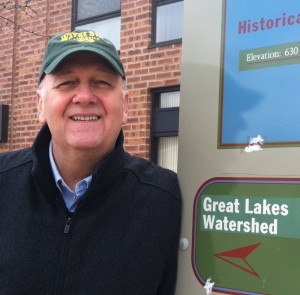
Gary Wilson
Commentary
Occasionally we all need to be reminded of the obvious – that which we take for granted.
That includes the dedicated Great Lakes environmental groups.
They’ve been relentlessly pressuring the White House for a permanent fix to the Chicago Waterways System that will stop Asian carp. The White House via the Army Corps of Engineers promised to deliver the results of its study on that hot button topic by 2015.
Not good enough, the environmentalists repeatedly said. They felt that the 2015 date didn’t recognize the urgency of the situation.
The White House listened and announced last week that it will present options for a “potential permanent solution” to stop advancing Asian carp by the end of 2013.
In addition to speeding the process, the White House press release said the new plan calls for “public engagement” and “collaboration with Congress.”
“This new step will result in a more focused path forward that could mean faster implementation of a permanent solution for protecting our Great Lakes from Asian carp,” John Goss, the Obama administration’s Asian carp director, said in a press release.
Jo-Ellen Darcy, assistant secretary of the Army for Civil Works said It’s an “optimized schedule…… to determine viable alternatives.”
Not impressed
Environmental groups were not impressed. While pleased with the 2013 date, they also wanted separation to be the only solution offered. They weren’t looking for options then a punt to Congress.
Reaction was swift.
In Chicago, Henry Henderson wrote in his blog that the White House announcement was “slick PR… a press conference about nothing.” Henderson is the Natural Resources Defense Council’s top regional executive.
He also wasn’t impressed with the “engaging Congress” statement, noting that it’s the same Congress that “can’t currently bring itself to fix crumbling bridges.” Implied:If it won’t fix bridges how will it design and construct a complex waterways system that will cost billions?
Across town, Joel Brammeier doesn’t like the options concept. He wants a plan for physical separation.
In a statement, he called for the administration to … “commit to the solution we know works — separation….” Brammeier runs the Alliance for the Great Lakes and was one of the first to call for physical separation of the Great Lakes from the Mississippi River.
Now what?
Where does that leave us?
Hopefully Henderson is wrong with his “slick PR” assertion. Time will tell.
And Brammeier may be right that physical separation will work. But telling the President and Congress that there’s only one way and it’s his way is a tough sell when you’re asking for billions of dollars to re-plumb America’s heartland.
But these PR skirmishes have nothing to do with the project’s biggest problem.
The concept of separating the Great Lakes from the Mississippi River is leaderless. No elected official with any gravitas or clout has taken ownership.
It’s clear that separation of the Great Lakes from the Mississippi isn’t a priority for the Obama administration. It has fought it in the courts and prevailed so far. Besides, in the current political and economic environment should anyone really expect the President to ask Congress for $5 billion for the Chicago Waterways System?
No!
President Obama has staked his Great Lakes reputation on restoration and he did that because environmental groups asked him to.
Others need to step forward
Political leadership for the separation concept needs to come from the outside the White House and it will have to include key figures in Illinois, Chicago and Indiana. To date, none have stepped up.
For proof, one only has to look at the statements of Illinois politicians Gov. Pat Quinn, Sen. Dick Durbin and Chicago Mayor Rahm Emanuel on the release this year of a similar separation feasibility study.
They acknowledged the problem and welcomed solutions, but not one of them made a case for separating the Great Lakes from the Mississippi River. Call it tepid support or damning with faint praise, but it wasn’t an endorsement.
I’m hard-pressed to name another special interest group that has done as well as Great Lakes environmentalists have with this administration.
They should slow down and reflect for a few minutes about the executive branch:
- They have a president who made a campaign pledge to fund Great Lakes restoration and he has, even in the most difficult of economic times.
- When the Asian carp issue blew up a few years ago they asked for one person to coordinate the response and they got the position and money to support it.
- They asked for a carp plan sooner than 2015 and essentially got the date, if not the preferred solution.
They’ve wished for a lot from Obama and most of those wishes have been granted. He’s the best friend the Great Lakes have ever had.
If you’re looking for someone to take the separation case to Washington, start with those heavyweight Illinois elected officials — Quinn, Emanuel and Durbin. The proposed reconfiguration of the waterways would happen on their turf.
They all have the president’s phone number.
